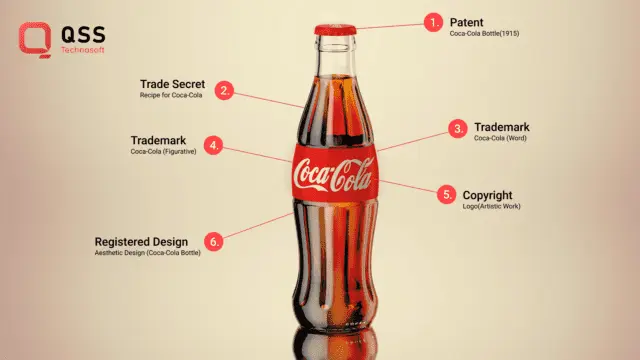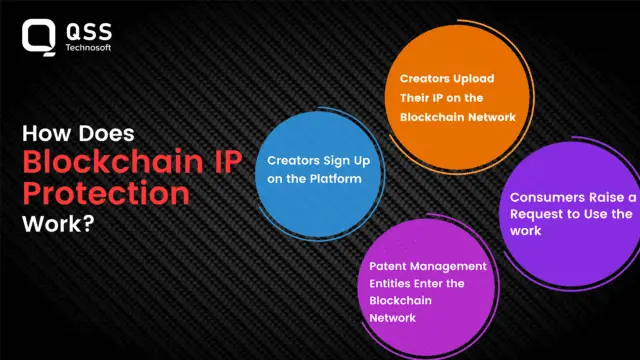How can we effectively protect blockchain intellectual property (IP) in a world dominated by digital technology? Indeed me, you & all are having this major question!
With the convenience of copying and distributing virtual content material, creators face a constant venture of stopping copyright infringements. It is important to find answers with a view to shield the rights of creators. One such answer that has won attention is the blockchain era.
But what exactly is blockchain and the way can it revolutionize the protection of intellectual belongings rights?
Well, to make it clear for your understanding nowadays, protecting IP has become increasingly difficult. According to a study by the Global Innovation Policy Center (GIPC), intellectual property theft costs the United States economy a staggering $225 billion to $600 billion annually. This statistic highlights the widespread problem of copyright infringement faced by creators.
To better recognize the impact of copyright infringement, let’s do not forget the music industry for example. With the upward push of track streaming structures and record-sharing networks, artists frequently struggle with unauthorized downloads and illegal distribution of their work.
This now not most effective hampers their potential to earn a dwelling however additionally dampens their motivation to create new and modern content
This article explores the ways in which blockchain can be employed as a solution to creators’ copyright problems.
Read Also: Blockchain development for Gaming Apps: A New Era of Play-to-Earn Opportunities
Understanding Intellectual Property Protection:
Understanding intellectual property protection is crucial for individuals and businesses to safeguard their creative works, inventions, and business ideas.
- Intellectual property refers to intangible assets such as patents, trademarks, copyrights, and trade secrets.
- These protections grant exclusive rights to the creator or owner of the intellectual property, ensuring that others cannot use, copy, or profit from their work without permission.
An example of intellectual property protection is the Coca-Cola trademark.
The unique logo, fonts, and colors used by Coca-Cola are not only recognizable worldwide but also legally protected. This means that no other company can use the same logo or brand elements to sell their products without facing legal consequences. The trademark protection allowed Coca-Cola to establish a strong brand identity and maintain its market presence.

Intellectual property protection promotes innovation and creativity by providing inventors, artists, and businesses with the confidence to invest time, resources, and talent into developing new ideas. It encourages economic growth and ensures fairness in the marketplace.
Read Also: How AI and Blockchain Are Reshaping the Insurance Sector?
Challenges in Copyright Protection for Creators:
Copyright protection for creators is essential to ensure that their creative works are not only protected but also that they receive compensation for them. However, this objective has become increasingly challenging in recent years due to the rise of the internet and digital technology.
Creators face many obstacles regarding copyright protection, and these challenges could worsen in the future.
Here are some of the challenges in copyright protection for creators:
- Piracy: The internet has made it easy for individuals to share digital content without permission. Piracy is a significant problem that creators face because it means that they can lose the income they deserve for their work. For instance, in 2016, the hit TV series Game of Thrones was the most pirated show, and a report by the TorrentFreak News website estimated that nearly a billion times the show was illegally downloaded.
- Enforcement of copyright laws: Even when there are robust copyright laws in place, enforcement of these laws can be a challenge for creators. This is because copyright violations may be challenging to detect, especially when they occur online. Furthermore, when violations are discovered, tracing the perpetrators or filing legal actions may be difficult.
- The grey area in copyright laws: There is a grey area in some copyright laws, which can make it challenging for creators to determine whether a particular usage of their content is legal or not. For instance, a user may argue that their use is “fair use” or “noncommercial use,” which can be challenging for creators to prove whether such uses should be compensated.
- The duration of copyright protection: Copyright protection can vary significantly from country to country, and determining which laws to follow can be daunting for creators. For instance, in the US, copyright protection can last up to 70 years after the creator’s death. In contrast, in some countries, copyright protection may expire much sooner than that.
Read Also: Revolutionize Mobile Gaming with Blockchain App Development using Web3
The Potential of Blockchain Technology:
Blockchain technology has emerged as a revolutionary concept that has the potential to reshape various industries and sectors. It is a decentralized, transparent, and secure digital ledger that enables the recording, storing, and sharing of data across a network of computers.

Blockchain protection
Here we are enlisting the potential of blockchain technology.
- Enhanced Security One of the key advantages of blockchain technology is its ability to provide added security. The decentralized nature of blockchain ensures that data is stored across multiple nodes, making it nearly impossible for hackers to tamper with the information. On top of that, the use of encryption algorithms adds an extra layer of security.
For example, in the finance industry, blockchain technology can be used to create secure and transparent transactions, eliminating the need for intermediaries and reducing the risk of fraud.
- Supply Chain Management Another potential application of blockchain technology is in supply chain management. By implementing blockchain, companies can create a transparent and immutable record of every transaction, from the manufacturer to the end consumer. This will help in verifying the authenticity and origin of products, reducing the risk of counterfeit goods.
For instance, Walmart has implemented blockchain technology to track the origin of certain food products, ensuring the safety and quality of its offerings.
- Healthcare Industry Blockchain technology also has the potential to revolutionize the healthcare industry. The use of blockchain can improve the security and privacy of patient data, making it easier for healthcare providers to share and access crucial medical information.
Blockchain can also be used to track the sourcing and supply chain of pharmaceutical products, ensuring the authenticity of drugs and reducing the risk of counterfeit medicines.
- Voting Systems Moreover, blockchain technology can be employed in voting systems to enhance transparency and security.
Blockchain can provide an immutable record of votes, preventing voter fraud or manipulation, and enabling citizens to verify their votes. This has the potential to improve democracy and trust in the electoral process.
- Smart Contracts Smart contracts are another significant aspect of blockchain technology. Smart contracts are self-executing contracts with predefined conditions and terms written in code on the blockchain.
These contracts automatically execute when the specified conditions are met. Smart contracts have the potential to streamline and automate various business processes, eliminating the need for intermediaries and reducing costs.
- Time-Stamped Proof of Creation Blockchain technology’s ability to provide a time-stamped proof of creation is essential for industries that require proof of existence or ownership.
By storing digital assets or documents on the blockchain, individuals and organizations can prove that a particular file or asset existed at a specific point in time, preventing fraud or disputes.
Read Also: Decentralised Finance (DeFi) Apps: Unlocking Financial Inclusion with Blockchain app development
Implementing Blockchain for IP Protection:
1. Creation registration: Creators can register their works on a blockchain platform designed specifically for copyright protection.
- Provide detailed descriptions and metadata about the work.
- Upload a digital copy or hash value of the work to establish ownership.
- Pay the required fees for copyright registration, if applicable.
2. Smart contract implementation: Use smart contracts to automatically enforce terms and conditions, such as licensing and royalty payments, when the work is used or sold.
- Define the licensing terms, usage rights, and royalty distribution in a smart contract.
- Use blockchain-enabled tokens to represent ownership rights and facilitate transparent royalty payments.
3. Copyright infringement detection: Blockchain can aid in detecting copyright infringements by monitoring and tracking the use of registered works.
- Employ algorithms to scan the internet for unauthorized use of copyrighted material.
- Create a decentralized platform where creators can report and flag potential infringing content.
- Incorporate AI and machine learning techniques to improve the accuracy and effectiveness of infringement detection.
4. Copyright dispute resolution: Blockchain’s transparent and tamper-proof nature can simplify the resolution of copyright disputes.
- Provide a traceable record of copyright ownership and usage history on the blockchain.
- Establish a decentralized dispute resolution mechanism, where independent arbitrators can assess evidence recorded on the blockchain.
- Create a more efficient and streamlined legal process for resolving copyright disputes.
Read Also: Chat GPT – Here is All About Viral AI Tool (In-Depth Analysis)
Challenges to Consider
- Adoption and integration: Widespread adoption of blockchain technology for IP protection may require significant integration efforts across platforms and industries.
- Scalability: Blockchain technology currently faces scalability challenges, limiting its potential to handle large-scale copyright registration and monitoring.
- Legal recognition: The legal framework around blockchain-based copyright protection needs further development and acceptance by regulatory authorities, particularly across different jurisdictions.
- User adoption and education: Users, including creators and consumers, need to be educated about the benefits and mechanisms of blockchain-based IP protection.
Conclusion:
Blockchain technology is poised to revolutionize how creators safeguard their copyrights in the digital age. Despite facing some implementation and adoption challenges, the potential benefits are substantial.
By continuing to foster collaboration between technology innovators, legal experts, and regulatory bodies, we can pave the way for greater protection of intellectual property.
QSS Technosoft, a leading technology solutions provider, has demonstrated expertise in blockchain development and can be an invaluable partner in helping creators harness the power of this transformative technology. Contact us today to explore how blockchain solutions can safeguard your intellectual property and propel your creative endeavors into the future.
We are proud to mention that our work has been recognized by leading B2B reviews and research platforms like GoodFirms, Clutch, MirrorView, and many more.


Is Blockchain Intellectual Property Protection the Answer to Creators’ Copyright Problems?